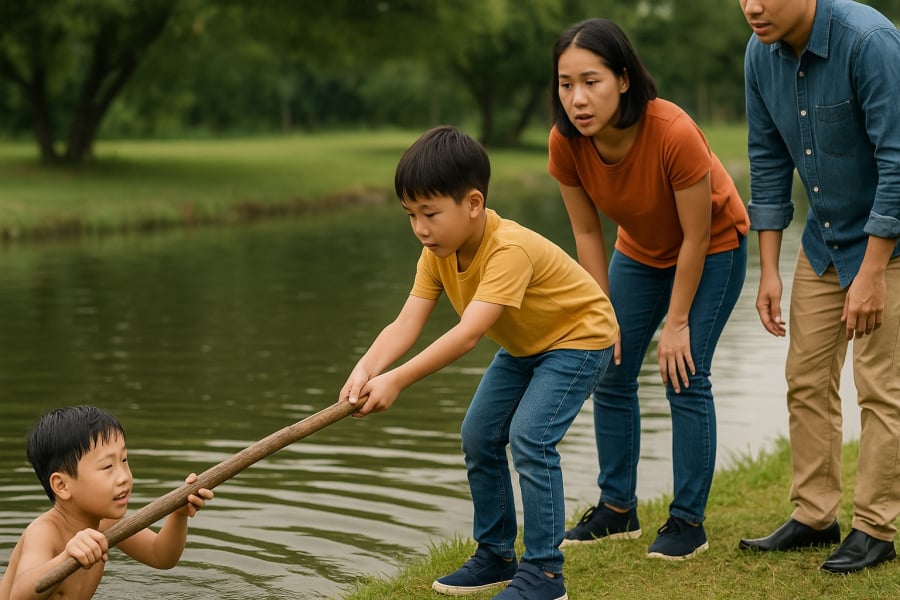
5 Essential Life Skills Children Should Learn Early to Protect Themselves and Help Others
Life-Saving Reflexes Come From Calmness, Not Just Strength
Sometimes the key to saving lives does not lie in physical strength, but in alertness and practical skills. For children, learning how to handle dangerous situations from an early age is not only a way to protect themselves, but also an opportunity to help others in critical moments.
Essential Life Skills Children Should Learn Early
Even at a young age, children are capable of learning and remembering important skills if they are guided properly. Below are five basic yet crucial life skills that parents should start teaching their children as soon as possible.
1. Recognizing Dangerous Situations
Children are often carefree and innocent, which makes it difficult for them to distinguish between ordinary events and truly dangerous situations. Teaching them how to identify warning signs is the foundation for developing quick and safe reactions instead of freezing in fear.
Examples: If a playmate suddenly sinks under water and does not resurface, if an adult collapses and remains motionless, or if someone is lying unconscious on the street—these are clear signals that a child must act immediately. However, they must also understand not to jump in themselves if it is beyond their ability to help.
2. Calling for Help the Right Way – Don’t Jump In

This may seem simple, but knowing how to call for help effectively can be a life-saving skill. Children should learn to shout loudly to attract attention and run to find the nearest adult, rather than trying to rescue the victim themselves.
A simple rule that children can remember is:
“Find an adult – Don’t jump in – Shout for help!”
Repeating this “magic phrase” through role-play and practice will help children build strong reflexes and respond calmly in real-life emergencies.
3. Using Tools Instead of Acting Recklessly
Many children, out of compassion, may impulsively jump into the water to save a friend even though they do not know how to swim. This is extremely dangerous. Parents should teach children that in emergencies, the safest option is to use available tools—a stick, a rope, a plastic container, or any floating object within reach—to help pull the victim to safety.
This approach not only ensures greater safety but also encourages children to think logically, act smartly, and stay calm instead of reacting emotionally.
4. Communicating in Stressful Situations

When someone is in distress, a few encouraging words can help them stay calm while waiting for help to arrive. Children should be taught that words carry enormous power in moments of fear.
Examples of helpful phrases:
-
“Hold on, help is coming!”
-
“I’m going to get an adult right now, don’t be afraid!”
Such words reassure the victim while also giving children a sense of control, reducing their own fear in frightening situations.
5. Practicing Until It Becomes a Habit
Children learn best through repetition and play. These skills should be integrated into games, role-play, and simple practice scenarios at home or school. With enough repetition, children will know how to stay calm, ask for help, and look for safe solutions instead of panicking.
What Parents Can Do
-
Introduce skills early: As soon as children are able to understand (around ages 3–4), parents can begin teaching these concepts in a lighthearted, age-appropriate way.
-
Turn practice into play: Pretend to be the “person in need” and let the child try reacting—shouting, fetching an object, or calling an adult. This makes learning fun and memorable.
-
Reinforce with questions: Regularly ask simple questions like, “If you see your friend sink in the pool, what do you do first?” This helps children recall the “golden rules.”
-
Avoid fear-based teaching: Do not use threats or frightening language, as this may cause unnecessary anxiety. Instead, explain the value and purpose of the skill.
-
Be a role model: Children imitate adults. When parents stop to help someone who has fallen or call for assistance, children absorb those behaviors.
-
Use educational videos: Watching short clips or animations about safety and then discussing them together can help children reinforce what they have learned.
Final Note
Life skills do not come only from books or expensive classes—they begin with the small lessons parents teach every day. By dedicating just a little time to practice and repetition, parents can give their children an invaluable gift: the ability to protect themselves and to help others when it matters most.
News in the same category


Is It Safe to Eat Rice Left Overnight in a Rice Cooker? A Personal Story and Expert Advice

Drinking perilla and lemon leaf tea brings these amazing health benefits to your body

Using just a handful of Paederia foetida leaves, even severe lung inflammation can clear within a week — with results that surprise everyone.

What Is the Purpose of the Small Bumps on the Rice Paddle in a Rice Cooker?

Pour This Down the Drain, and Your Kitchen Will No Longer Smell Bad

When Putting Your Phone in Your Pocket, Should the Screen Face Inward or Outward?

Why You Shouldn’t Use Your Mobile Phone While Going to the Bathroom

Just Add a Few Drops of This, and Even the Strongest Super Glue Will Dissolve Instantly

A Frightening Revelation from Experts About Drying Clothes Indoors – Should You Do It or Not?

Should You Remove the Black Vein on the Back of Shrimp? Many People Are Still Doing It Wrong

Pouring Salt into a Clogged Toilet – You’ll Be Surprised at the Reason Why So Many People Do This

3 Ways to Prevent Snakes from Entering Your Home – Everyone Should Know to Protect Their Family

5 Mistakes When Drinking Coffee That Harm Your Health: Especially, Mistake #2 – Stop Immediately Before It’s Too Late

6 Types of People Who Should Absolutely Avoid Eating Duck Meat, No Matter How Much They Crave It

Top 8 Most Power-Hungry Devices, Using Twice as Much Electricity as Air Conditioners: Remember to Unplug After Use or Your Bills Will Skyrocket

Mosquitoes Fear This Simple Bowl of Water — Place It in Your Home, and Even the Most Persistent Mosquitoes Will Leave, Letting You Sleep Peacefully

Super Simple Toilet Cleaning Tip Using Just a Toilet Paper Roll Core and Vinegar
News Post

Delta Pilot Spends Year’s Salary to Fly 112 Friends to Hawaii for Epic Retirement Sendoff

1 cup before bed: end restless nights and repair your nerves

5 foods that heal your body and STARVE cancer—eat these now!

Mixing Beer with Sugar or Detergent: A Brilliant Solution to a Common Household Problem You Shouldn’t Miss

A Wild Herb That Grows Like Weeds, Used in Soups to Nourish the Liver and Strengthen Joints, Yet Most Vietnamese People Always Pull It Out When They See It

Is It Safe to Eat Rice Left Overnight in a Rice Cooker? A Personal Story and Expert Advice

Unbelievable footage shows moment Ukraine blows up two key Russian bridges using their own mines amid WW3 fears

Preventing Stroke At Any Age: 3 “Don’ts” After Meals—And 4 “Don’ts” Before Bed

Apple’s iPhone Users Are Justifiably Concerned By The New Meaning Of The Orange Dot On Their Screens

The Truth About “Old Person Smell”: What Causes It And How To Get Rid Of It

12 surprising foods that help dissolve blood clots naturally

Drinking perilla and lemon leaf tea brings these amazing health benefits to your body

Using just a handful of Paederia foetida leaves, even severe lung inflammation can clear within a week — with results that surprise everyone.

New B::l:ood Pressure Guidelines: 4 Things I Like and 2 Concerns

Intuitive Eating: A Non-Diet Approach Your Patients May Love

Saw This Trick For Oven Cleaning

Global Prevalence of Hidradenitis Suppurativa Approaches 1%

Who Should Avoid Eating Chicken Feet?
